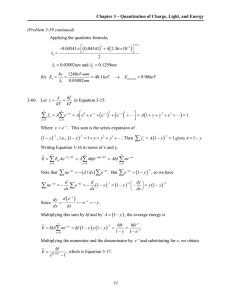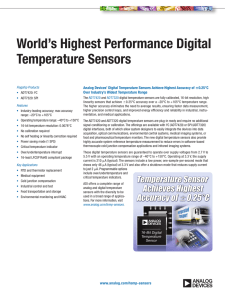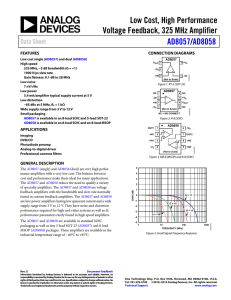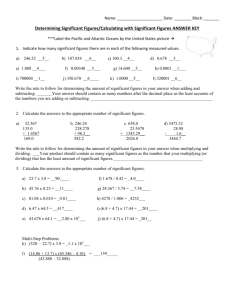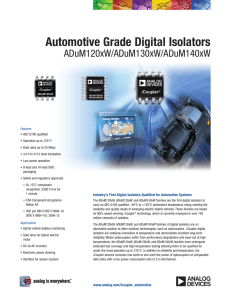Multiplying DACs Flexible Building Blocks
advertisement
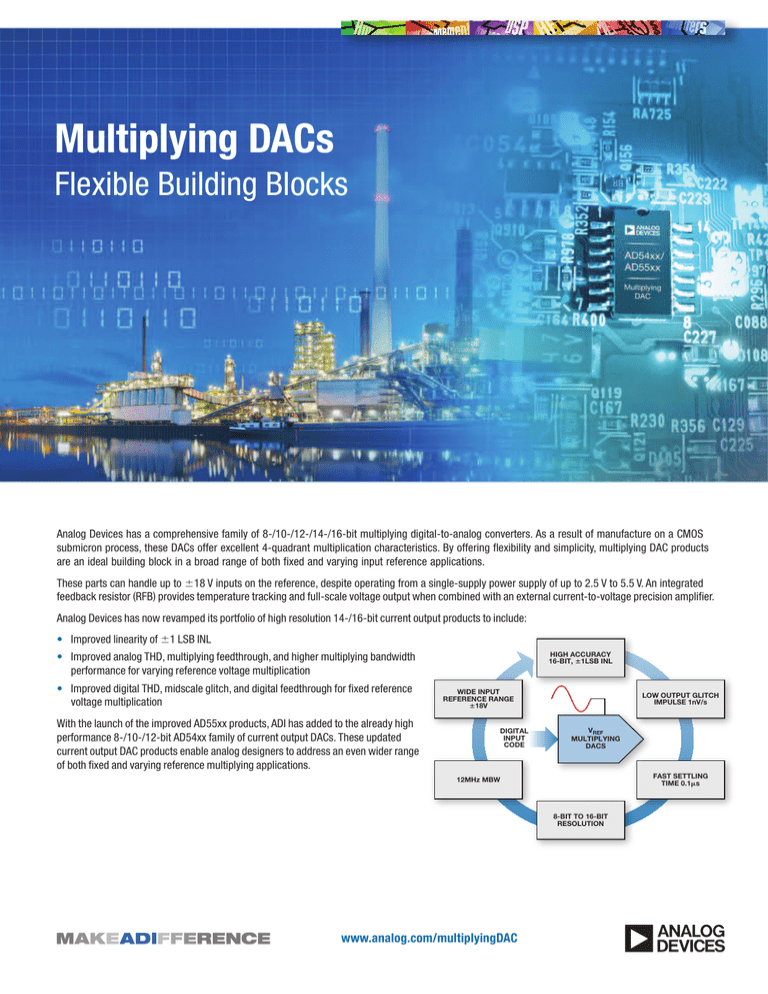
Multiplying DACs Flexible Building Blocks Analog Devices has a comprehensive family of 8-/10-/12-/14-/16-bit multiplying digital-to-analog converters. As a result of manufacture on a CMOS submicron process, these DACs offer excellent 4-quadrant multiplication characteristics. By offering flexibility and simplicity, multiplying DAC products are an ideal building block in a broad range of both fixed and varying input reference applications. These parts can handle up to ±18 V inputs on the reference, despite operating from a single-supply power supply of up to 2.5 V to 5.5 V. An integrated feedback resistor (RFB) provides temperature tracking and full-scale voltage output when combined with an external current-to-voltage precision amplifier. Analog Devices has now revamped its portfolio of high resolution 14-/16-bit current output products to include: • Improved linearity of ±1 LSB INL HIGH ACCURACY 16-BIT, ±1LSB INL • Improved analog THD, multiplying feedthrough, and higher multiplying bandwidth performance for varying reference voltage multiplication • Improved digital THD, midscale glitch, and digital feedthrough for fixed reference voltage multiplication With the launch of the improved AD55xx products, ADI has added to the already high performance 8-/10-/12-bit AD54xx family of current output DACs. These updated current output DAC products enable analog designers to address an even wider range of both fixed and varying reference multiplying applications. WIDE INPUT REFERENCE RANGE ±18V DIGITAL INPUT CODE LOW OUTPUT GLITCH IMPULSE 1nV/s VREF MULTIPLYING DACS FAST SETTLING TIME 0.1𝛍s 12MHz MBW 8-BIT TO 16-BIT RESOLUTION www.analog.com/multiplyingDAC Multiplying DACs By offering both flexibility and simplicity, multiplying DACs can be used in a broad range of applications. The benefit of a discrete DAC and op amp solution is that the op amp selection can be custom tailored to suit the application requirements. Multiplying DACs are ideal building blocks for fixed reference applications, where the user wants to generate a waveform from a fixed dc voltage. They are also ideally suited for varying reference applications, where the user wants to digitally condition an ac or arbitrary reference voltage. The AD54xx and revamped AD55xx families of multiplying DACs have been designed to target both these application spaces. Multiplying DACs have a number of extra features to assist designers in generating the desired output signal. Some multiplying DACs, such as the AD5405 and AD5545, include uncommitted matched resistors, whereby a positive output can be obtained simply by connecting an additional op amp (A2 in Figure 2), which could be the companion op amp within a dual device. Some generics of the family, including the AD5546 and AD5544, have the added feature of resetting to midscale or zero scale, which is useful in bipolar applications. The required op amp to support these applications can be selected for particular specifications, for example, high gain bandwidth, high slew rate, low noise, etc. Key Advantages of AD55xx DACs for Multiplying AC/Arbitrary Reference Applications • High multiplying bandwidth — signals can be multiplied up to this frequency before they are attenuated by more than 3 dB. The AD5544/AD5554 can multiply signals up to 12 MHz. See Figure 1. • Low multiplying feedthrough — this is the error due to capacitive feedthrough from the reference input to the DAC output, when all 0’s are loaded to the DAC. This measures the amount of possible distortion in the multiplied signal — the AD5544 measures as low as –65 dB at 100 kHz. • Excellent analog THD — a mathematical representation of the harmonic content in the multiplied waveform signal. It is the rms sum of the harmonics (V2, V3, V4, and V5) of the DAC output to the fundamental value, V1, given by Equation 1. Measures as low as –103 dB on the AD5543. THD = 20 log V2 2 + V3 2 + V4 2 + V5 2 (1) V1 AC REFERENCE VDD VREF 0V C1 RFB AD55xx IOUT1 A1 0V AGND SYNC SCLK SDIN ATTENUATED REFERENCE AGND MICROCONTROLLER C1 = 2 C0 1 × 2𝛑 × RFB GBW WHERE: CO = OUTPUT IMPEDANCE OF DAC GBW = GAIN BANDWIDTH PRODUCT OF OP AMP Figure 1. Multiplying DAC — varying reference — positive reference in/negative out configuration. Circuit Note CN-0025, Precision, AC Reference Signal Attenuator Using the AD5546/AD5556 Multiplying DAC. www.analog.com/CN0025 AN-1094 Application Note, Multiplying DACs — Fixed Reference, Waveform Generation Applications. www.analog.com/AN-1094 A2 C2 AC REFERENCE RCOM VREF ROFS R1 VDD AD55xx 0V SYNC SCLK SDIN RFB C1 IOUT1 ATTENUATED REFERENCE A1 AGND 0V AGND MICROCONTROLLER Figure 2. Multiplying DAC — varying*UNCOMMITTED reference — positive reference in/positive out configuration. RESISTOR VERSIONS ONLY 2 | Multiplying DACs Key Advantages of AD55xx DACs for Multiplying DC Reference Applications • Fast settling time — the AD55xx benefit from a 0.5 µs settling time from zero scale to full scale within ±0.1%. The AD54xx have zero scale to full scale settling time of sub 0.1 µs to within ±0.1%. • High slew rate — due to fast switching architecture of the AD54xx and AD55xx families, an operational amplifier with a slew rate of >100 V/µs is sufficient to not limit the DAC performance. • Low glitch — low in R2R structures due to the fact that the current is steered either to ground or virtual ground. The worst case is the midscale glitch, which can measure as low as –1 nV/s for the AD55xx parts. • Low noise — the AD54xx and AD55xx family of IOUT DACs utilize low impedance architectures. These are inherently low noise architectures dominated by the thermal noise of the RDAC resistor. VDD +VE VREF VREF C1 RFB AD55xx 0V IOUT1 GENERATED WAVEFORM A1 AGND 0V SYNC SCLK SDIN AGND MICROCONTROLLER Figure 3. Multiplying DAC — fixed reference — unipolar operation. AN-1085 Application Note, Multiplying DACs — AC/Arbitrary Reference Applications. www.analog.com/AN-1085 R3 10k𝛀 R5 10k𝛀 R2 VDD +VE VREF 0V R1 VREF C1 RFB AD55xx IOUT1 A1 GENERATED WAVEFORM R4 5k𝛀 AGND A2 0V SYNC SCLK SDIN AGND MICROCONTROLLER NOTES 1. R1 AND R2 ARE USED ONLY IF GAIN ADJUSTMENT IS REQUIRED. ADJUST R1 FOR VOUT = 0V WITH CODE 10000000 LOADED TO DAC. 2. MATCHING AND TRACKING ARE ESSENTIAL FOR RESISTOR PAIRS R3 AND R4. Figure 4. Multiplying DAC — fixed reference — bipolar operation. Circuit Note CN-0028, Precision, Bipolar Configuration for the AD5547/AD5557 DAC. www.analog.com/CN0028 www.analog.com/multiplyingDAC | 3 IOUT Family Tree AD5543/AD5544/AD5545/ AD5546/AD5547 16-BIT, 1LSB, SINGLE-/DUAL-/QUAD-CHANNEL SPI/PARALLEL >10MHz MULTIPLYING BANDWIDTH RESOLUTION AD5553/AD5554/ AD5555/AD5556/AD5557/ AD5453/AD5446 AD5415/ AD5441/AD5443/AD5444/ AD5445/AD5447/AD5449/ AD5452/AD5405 AD5450/AD5451/ AD5424/AD5425/AD5426/ AD5428/AD5429/ AD5433/AD5440 14-BIT, 1LSB, SINGLE-/DUAL-/QUAD-CHANNEL SPI/PARALLEL >10MHz MULTIPLYING BANDWIDTH 12-BIT, SINGLE-/DUAL-CHANNEL SPI/PARALLEL >10MHz MULTIPLYING BANDWIDTH LFCSP/MSOP/TSSOP 8-/10-BIT, SINGLE-/DUAL-CHANNEL SPI/PARALLEL >10MHz MULTIPLYING BANDWIDTH MSOP/TSSOP AD54xx AD55xx AD5543 Specifications AD5544 Specifications • Single channel • Quad channel • 16-bit resolution • 16-bit resolution • ±1 LSB DNL • ±1 LSB DNL • ±1 LSB INL • ±1 LSB INL • Low noise: 12 nV/√Hz • 2 mA full-scale current ±20%, with VREF = ±10 V • Low power: IDD = 10 µA • 0.9 µs settling time to ±0.1% • 0.5 µs settling time • 12 MHz multiplying bandwidth • 7 MHz multiplying bandwidth • Midscale glitch of −1 nV/sec • Analog THD of –103 dB • Midscale or zero-scale reset • 2 mA full-scale current ±20%, with VREF = 10 V • Four separate, 4-quadrant multiplying reference inputs • Built-in RFB facilitates voltage conversion • SPI-compatible, 3-wire interface • SPI-compatible, 3-wire interface • Simultaneous multichannel change • Temperature range: −40°C to +125°C • Temperature range: −40°C to +125°C • Ultracompact 8-lead MSOP and 8-lead SOIC packages • Compact 28-lead SSOP; 5 mm × 5 mm, 32-lead LFCSP 4 | Multiplying DACs Applications Low Noise LED Control ADC MICROCONTROLLER DAC CONTROL A C1 RFB IOUT1 A1 VDD AD55xx AGND PHOTODIODE + I/V AMP VREF LPF AGND Fast Settling Ramp Control on Motors VDD VREF C1 RFB AD55xx IOUT1 A1 AGND MOTOR CONTROL SYNC SCLK SDIN AGND MASS SPECTROMETER MICROCONTROLLER ADC DETECTOR + SIGNAL CONDITIONING 1 CH1 200mV M400ns A CH1 412mV Circuits from the Lab™ by Analog Devices is a new design assistance resource that provides engineers with tested circuit solutions for many common applications. Circuits from the Lab pairs at least two complementary components, such as an ADC and amplifier, to present a circuit optimized for a targeted application. Each circuit has been built and tested in the lab and can be easily integrated into designs, resulting in reduced design risk and faster time to market. Circuit note documentation accompanies each Circuits from the Lab design and describes the circuit function, benefits, and implementation in detail, with common variations noted. View the collection of circuit notes available for multiplying DAC designs at www.analog.com/circuits. www.analog.com/multiplyingDAC | 5 Applications Single-Ended-to-Differential Conditioning A2 C2 RCOM AC REFERENCE VREF ROFS R1 VDD C1 IOUT1 AD55xx 1.5V A3 RFB DIFFERENTIAL OUTPUT VOLTAGE A1 AGND 1.5V SYNC SCLK SDIN AGND 1.5V A4 1.5V MICROCONTROLLER *UNCOMMITTED RESISTOR VERSION Circuit Note CN-0143, Single-Ended-to-Differential Converters for Voltage Output and Current Output DACs Using the AD8042 Op Amp. www.analog.com/CN0143 Fast Settling Ramp Generation and Offset Control RFBA GENERATED WAVEFORM AD5545 16-BIT ADR423 3.0V VREFA C1 OFFSET DAC IOUTA A1 0V VDD AD5621 12-BIT VOUT VREFB AWG DAC IOUTB AGND For more information on ADI’s multiplying DAC portfolio see www.analog.com/multiplyingDAC. 6 | Multiplying DACs Multiplying DACs Part Number Bits Outputs Interface Package Comments AD5424 8 1 Parallel 16-lead TSSOP, 20-lead LFCSP AD5426 8 1 SPI 10-lead MSOP >10 MHz BW, ±10 V signals; see also AD5425 fast load AD5450 8 1 SPI 8-lead SOT-23 Small SOT-23 package; see also AD5425 fast load; pin- and softwarecompatible family —12 MHz update rate AD5425 8 1 SPI, 8-bit load 10-lead MSOP >10 MHz BW, ±10 V signals; see also AD5426 AD5428 8 2 Parallel 20-lead TSSOP >10 MHz BW, ±10 V signals AD5429 8 2 SPI 16-lead TSSOP >10 MHz BW, ±10 V signals AD5433 10 1 Parallel 20-lead TSSOP, 20-lead LFCSP >10 MHz BW, ±10 V signals AD5432 10 1 SPI 10-lead MSOP >10 MHz BW, ±10 V signals AD5451 10 1 SPI 8-lead SOT-23 Small SOT-23 package; pin- and software-compatible family AD5439 10 2 SPI 16-lead TSSOP >10 MHz BW, ±10 V signals AD5440 10 2 Parallel 24-lead TSSOP >10 MHz BW, ±10 V signals AD5445 12 1 Parallel 20-lead TSSOP, 20-lead LFCSP >10 MHz BW, ±10 V signals AD5443 12 1 SPI 10-lead MSOP >10 MHz BW, ±10 V signals AD5452 12 1 SPI 8-lead SOT-23, 8-lead MSOP DAC8043A 12 1 SPI 8-lead TSSOP AD5441 12 1 SPI 8-lead LFCSP, 8-lead MSOP AD5444 12 1 SPI 10-lead MSOP Higher accuracy version of AD5443; see also AD5452 AD5447 12 2 Parallel 24-lead TSSOP >10 MHz BW, ±10 V signals AD5405 12 2 Parallel 40-lead LFCSP >10 MHz BW, ±10 V signals, uncommitted resistors AD5449 12 2 SPI 16-lead TSSOP >10 MHz BW, ±10 V signals AD5415 12 2 SPI 24-lead TSSOP >10 MHz BW, ±10 V signals, uncommitted resistors AD5556 14 1 Parallel 28-lead TSSOP ±1 LSB, 6 MHz BW, ±15 V signals AD5453 14 1 SPI 8-lead SOT-23, 8-lead MSOP Small SOT-23 package; pin- and software-compatible family AD5553 14 1 SPI 8-lead MSOP, 8-lead SOIC_N 4 MHz BW, ±15 V signals AD5446 14 1 SPI 10-lead MSOP MSOP version of AD5453; compatible with AD5443, AD5432, and AD5426 AD5557 14 2 Parallel 38-lead TSSOP ±1 LSB, 6 MHz BW, ±15 V signals AD5555 14 2 SPI 16-lead TSSOP ±1 LSB, 6 MHz BW, ±15 V signals AD5554 14 4 SPI 28-lead SOP ±1 LSB, 12 MHz BW, ±15 V signals AD5546/ AD5546A 16 1 Parallel 28-lead TSSOP ±1 LSB, 6 MHz BW, ±15 V signals AD5543 16 1 SPI 8-lead MSOP, 8-lead SOIC_N ±1 LSB, 6 MHz BW, ±15 V signals AD5547 16 2 Parallel 38-lead TSSOP ±1 LSB, 6 MHz BW, ±15 V signals AD5545 16 2 SPI 16-lead TSSOP ±1 LSB, 6 MHz BW, ±15 V signals AD5544 16 4 SPI 28-lead SSOP, 32-lead LFCSP ±1 LSB, 12 MHz BW, ±15 V signals >10 MHz BW, ±10 V signals 12 MHz BW, small SOT-23 package; pin- and software-compatible family >2 MHz bandwidth; see AD5443, also AD5452 and AD5444 Low noise, 1 LSB, 1 μs settling time, LDAC pin, upgrade to DAC8043A www.analog.com/multiplyingDAC | 7 Op Amp Selection The performance of a multiplying DAC solution is strongly dependent on the selected op amp to perform the current-to-voltage conversion. In order to maintain the dc accuracy of the signal, it is important to select an op amp with low bias current and low offset voltage so as not to swamp the minimum resolution of the DAC’s output. More detail on this is included in the multiplying DAC’s data sheet. For applications where a relatively high speed ac or arbitrary signal needs to be multiplied, a high bandwidth/high slew rate op amp is required to prevent the op amp from degrading the output signal. The gain bandwidth product of an op amp will be limited by the feedback load it sees with the feedback resistor. To determine what GBW is required, the user needs to be conscious of the gain configuration. The higher the gain, the lower the bandwidth. As a rule of thumb, a bandwidth of 10 times the desired frequency for a gain configuration of –1 is generally sufficient. The slew rate of the op amp is another specification that can limit the multiplying DAC if careful consideration is not given. As a rule of thumb, for the AD54xx and AD55xx family of DACs, an op amp with a slew rate of 100 V/μs is generally sufficient. The selection tables below list operational amplifiers that can be used for multiplying applications. Suitable Op Amps for High Precision Applications Part Number OP97 OP1177 AD8675 AD8671 ADA4004-1 AD8607 AD8605 AD8615 AD8616 Supply Voltage (V) VOS Maximum (𝛍V) IB Maximum (nA) 0.1 Hz to 10 Hz Noise (𝛍V p-p) Supply Current (𝛍A) Package ±2 to ±20 ±2.5 to ±15 ±5 to ±18 ±5 to ±15 ±5 to ±15 1.8 to 5 2.7 to 5 2.7 to 5 2.7 to 5 25 60 75 75 125 50 65 65 65 0.1 2 2 12 90 0.001 0.001 0.001 0.001 0.5 0.4 0.1 0.077 0.1 2.3 2.3 2.4 2.4 600 500 2300 3000 2000 40 1000 2000 2000 8-lead SOIC, 8-lead PDIP 8-lead MSOP, 8-lead SOIC 8-lead MSOP, 8-lead SOIC 8-lead MSOP, 8-lead SOIC 8-lead SOIC, 5-lead SOT-23 8-lead MSOP, 8-lead SOIC 5-lead WLCSP, 5-lead SOT-23 5-lead TSOT 8-lead MSOP, 8-lead SOIC Suitable Op Amps for High Speed Applications Part Number AD8065 AD8066 AD8021 AD8038 ADA4899 AD8057 AD8058 AD8061 AD8062 AD9631 Supply Voltage (V) –3 dB BW (MHz) Slew Rate (V/𝛍s) VOS Max (𝛍V) IB Max (nA) Package 5 to 24 5 to 24 5 to 24 3 to 12 5 to 12 3 to 12 3 to 12 2.7 to 8 2.7 to 8 ±3 to ±6 145 145 490 350 600 325 325 320 320 320 180 180 120 425 310 1000 850 650 650 1300 1500 1500 1000 3000 35 5000 5000 6000 6000 10,000 0.006 0.006 10,500 750 100 500 500 350 350 7000 8-lead SOIC, 5-lead SOT-23 8-lead SOIC, 8-lead MSOP 8-lead SOIC, 8-lead MSOP 8-lead SOIC, 5-lead SC70 8-lead LFCSP, 8-lead SOIC 5-lead SOT-23, 8-lead SOIC 8-lead SOIC, 8-lead MSOP 5-lead SOT-23, 8-lead SOIC 8-lead SOIC, 8-lead MSOP 8-lead SOIC, 8-lead PDIP Analog Devices, Inc. Worldwide Headquarters Analog Devices, Inc. Three Technology Way P.O. Box 9106 Norwood, MA 02062-9106 U.S.A. Tel: 781.329.4700 (800.262.5643, U.S.A. only) Fax: 781.461.3113 Analog Devices, Inc. Europe Headquarters Analog Devices, Inc. Wilhelm-Wagenfeld-Str. 6 80807 Munich Germany Tel: 49.89.76903.0 Fax: 49.89.76903.157 Analog Devices, Inc. Japan Headquarters Analog Devices, KK New Pier Takeshiba South Tower Building 1-16-1 Kaigan, Minato-ku, Tokyo, 105-6891 Japan Tel: 813.5402.8200 Fax: 813.5402.1064 Analog Devices, Inc. Southeast Asia Headquarters Analog Devices 22/F One Corporate Avenue 222 Hu Bin Road Shanghai, 200021 China Tel: 86.21.2320.8000 Fax: 86.21.2320.8222 ©2010 Analog Devices, Inc. All rights reserved. Trademarks and registered trademarks are the property of their respective owners. Printed in the U.S.A. BR09270-1.2-12/10 www.analog.com/multiplyingDAC

